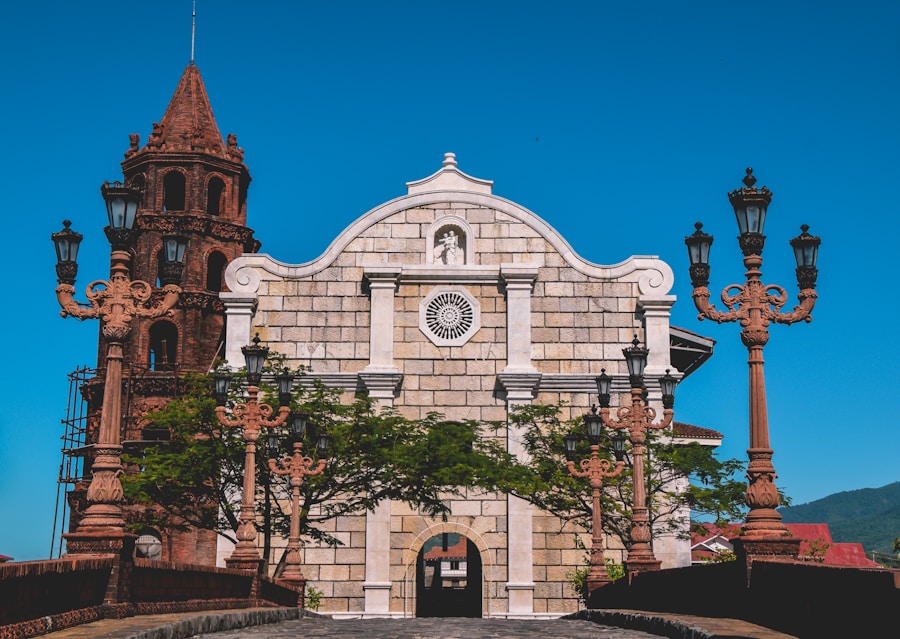Download links
How to install Manila Cathedral: A Historic Gem in the Philippines APK?
1. Tap the downloaded Manila Cathedral: A Historic Gem in the Philippines APK file.
2. Touch install.
3. Follow the steps on the screen.
Description
The Manila Cathedral, officially known as the Cathedral-Basilica of the Immaculate Conception, has a rich and storied history that reflects the tumultuous past of the Philippines. Its origins can be traced back to 1581 when the first church was constructed on the site, serving as the seat of the Archdiocese of Manila. This initial structure was made of bamboo and nipa palm, a humble beginning that belied the cathedral’s future significance.
Over the years, the church underwent several reconstructions due to natural disasters and conflicts, including fires and earthquakes that plagued Manila throughout its history. The most significant of these calamities occurred in 1863 when a powerful earthquake destroyed much of the original structure. In 1958, after a series of reconstructions and renovations, the Manila Cathedral was consecrated as a basilica by Pope John
Key Takeaways
- Manila Cathedral has a rich history dating back to the 16th century, with several reconstructions due to natural disasters and war.
- The architectural features of Manila Cathedral include a combination of Romanesque, Renaissance, and Baroque styles, with intricate carvings and stained glass windows.
- Significant events at Manila Cathedral include the canonization of Filipino saints and the visit of Pope John Paul II in 1981.
- Restoration and preservation efforts have been ongoing to maintain the historical and cultural significance of Manila Cathedral.
- Manila Cathedral holds cultural and religious significance as a symbol of faith and resilience for the Filipino people. It is also a popular tourist destination for its historical and architectural value.
This designation not only elevated its status within the Catholic Church but also solidified its role as a central place of worship for Filipino Catholics. The cathedral has witnessed numerous historical events, including the proclamation of Philippine independence and various papal visits, making it a symbol of resilience and faith for the Filipino people. Each iteration of the cathedral has contributed to its legacy, with each architectural style reflecting the era in which it was built, from Spanish colonial influences to modernist touches.
Architectural Features of Manila Cathedral

The architectural design of Manila Cathedral is a testament to its historical evolution and cultural significance. The current structure, completed in 1958, showcases a blend of Romanesque and Neo-Romanesque styles, characterized by its grand façade adorned with intricate carvings and sculptures. The cathedral’s imposing entrance features a series of arches that lead into a spacious interior, where visitors are greeted by soaring ceilings and beautifully crafted stained glass windows.
These windows depict various biblical scenes and saints, adding a vibrant touch to the otherwise solemn atmosphere. One of the most striking features of the Manila Cathedral is its impressive bell tower, which stands at 83 meters tall. This tower not only serves as a visual landmark in the Manila skyline but also houses several bells that have been cast from different materials over the years.
The largest bell, known as the “Great Bell of Manila,” weighs over 1,000 kilograms and is used to signal important events within the church calendar. The cathedral’s altar is another focal point, featuring a stunning mosaic that depicts the Immaculate Conception, surrounded by ornate decorations that reflect the artistry of Filipino craftsmen. The overall design harmonizes with the surrounding landscape, creating a serene environment for worshippers and visitors alike.
Significant Events at Manila Cathedral
| Date | Significant Event |
|---|---|
| 1581 | Manila Cathedral was established as a church by the Spanish government |
| 1762 | The cathedral was used as a stable by the British during their occupation of Manila |
| 1958 | Manila Cathedral was elevated to the rank of minor basilica by Pope Pius XII |
| 2012 | The cathedral was heavily damaged by a typhoon, leading to a major restoration project |
| 2021 | The cathedral celebrated its 442nd anniversary with various events and activities |
Throughout its history, Manila Cathedral has been the site of numerous significant events that have shaped both religious and national identity in the Philippines. One notable occasion was the funeral of President Manuel L. Quezon in 1944, which drew thousands of mourners and highlighted the cathedral’s role as a national symbol during times of grief.
The cathedral has also hosted various important religious ceremonies, including ordinations and confirmations, which are pivotal moments in the lives of many Filipino Catholics. In addition to religious events, Manila Cathedral has played a crucial role in political history. It served as a venue for significant gatherings during the People Power Revolution in 1986, where thousands congregated to demand democratic reforms.
This peaceful uprising ultimately led to the ousting of President Ferdinand Marcos and marked a turning point in Philippine history. The cathedral’s walls have witnessed countless prayers for peace and justice, making it not just a place of worship but also a sanctuary for social change.
Restoration and Preservation Efforts
The preservation of Manila Cathedral has been an ongoing endeavor, particularly in light of the various natural disasters that have threatened its structural integrity over the years. After suffering extensive damage during World War II, significant restoration efforts were initiated under the guidance of architect Fernando Ocampo. His work focused on restoring the cathedral to its former glory while incorporating modern engineering techniques to ensure its longevity.
The restoration process involved meticulous attention to detail, with artisans painstakingly recreating original elements that had been lost or damaged. In recent years, further restoration efforts have been undertaken to address wear and tear caused by time and environmental factors. These initiatives have included cleaning and repairing stained glass windows, reinforcing structural elements, and restoring decorative features that reflect the cathedral’s rich artistic heritage.
The Archdiocese of Manila has also engaged in community outreach programs to raise awareness about the importance of preserving this historical landmark. By involving local artisans and craftsmen in restoration projects, these efforts not only safeguard the cathedral’s physical structure but also promote cultural heritage and craftsmanship within the community.
Cultural and Religious Significance

Manila Cathedral holds profound cultural and religious significance for Filipinos, serving as a symbol of faith and resilience in the face of adversity. As one of the oldest churches in the Philippines, it represents the deep-rooted Catholic traditions that have shaped Filipino identity over centuries. The cathedral is not only a place for individual worship but also serves as a gathering space for communal celebrations such as Christmas Masses, Holy Week observances, and other significant liturgical events that draw thousands of attendees each year.
The cathedral’s role extends beyond religious practices; it is also a cultural hub where art and spirituality intersect. Various art exhibits and concerts are held within its walls, showcasing Filipino talent while fostering a sense of community among attendees. The annual Feast of the Immaculate Conception is celebrated with great fervor at Manila Cathedral, drawing pilgrims from across the country who come to pay homage to their patroness.
This event exemplifies how the cathedral serves as a focal point for both spiritual devotion and cultural expression, reinforcing its status as an integral part of Filipino heritage.
Visitor Information and Tours
For those wishing to explore Manila Cathedral, visitor information is readily available to ensure an enriching experience.
Guided tours are offered in multiple languages, providing insights into the architectural features, historical significance, and cultural context of this iconic landmark.
Knowledgeable guides share stories about key events that have taken place within its walls, enhancing visitors’ understanding of its importance. Visitors are encouraged to dress modestly when entering the cathedral as a sign of respect for its sacred nature. Photography is permitted in designated areas; however, visitors are asked to maintain silence during services to preserve the solemn atmosphere.
The surrounding area offers various amenities such as cafes and souvenir shops where visitors can purchase mementos or enjoy local delicacies after their tour. Overall, a visit to Manila Cathedral provides not only an opportunity to appreciate its architectural beauty but also a chance to connect with the rich spiritual heritage that it embodies.
If you’re interested in exploring more about historical landmarks in the Philippines, you may want to check out this article on Lords Mobile: Guerra de Reinos – Batalla MMO RPG. This game allows players to engage in battles and conquer kingdoms, which could be a fun way to immerse yourself in the rich history of places like the Manila Cathedral.
FAQs
What is the Manila Cathedral?
The Manila Cathedral, also known as the Metropolitan Cathedral of the Immaculate Conception, is a Roman Catholic basilica located in the Intramuros district of Manila, Philippines.
When was the Manila Cathedral built?
The original Manila Cathedral was built in 1581, but it has been destroyed and rebuilt several times due to natural disasters and wars. The current structure was completed in 1958.
What is the architectural style of the Manila Cathedral?
The Manila Cathedral features a combination of architectural styles, including Baroque, Neo-Romanesque, and Neo-Byzantine influences.
What is the significance of the Manila Cathedral?
The Manila Cathedral is a significant religious and cultural landmark in the Philippines. It has been the site of many important events in the country’s history, including the papal visits of Pope Paul VI, Pope John Paul II, and Pope Francis.
Is the Manila Cathedral open to the public?
Yes, the Manila Cathedral is open to the public for worship, prayer, and guided tours. Visitors are welcome to explore the cathedral’s interior and learn about its history and significance.





